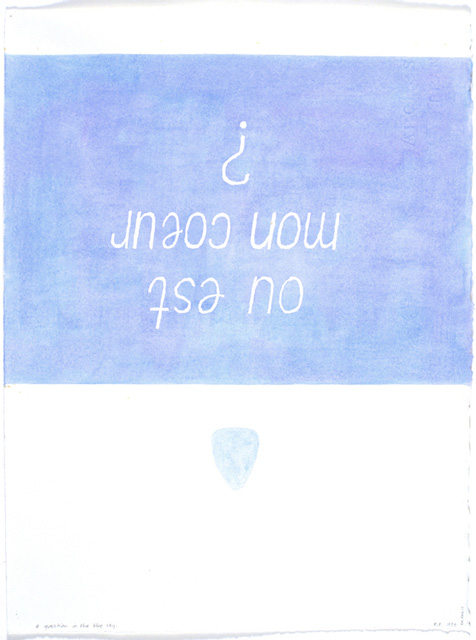


There is something ghost-like about the works of Rosslynd Piggott, something ungraspable, as though these works are apparitions. They are there, but at the same time not quite there. It is as though your hand would pass right through the canvas or object, not leaving a mark. In A question in the blue sky (1994), the question 'Où est mon cœur?' (Where is my heart?) floats lightly in the gentle nothingness of the bleached and watery sky. In the imagination it drifts, a surreal and specific cloud form which will, with a little time, disperse, leaving the sky untarnished.
As an artist, Rosslynd Piggott treads softly. As Frances Lindsay has noted:
Objects which exist in tangible form, such as buildings or even quattrocento paintings in the Louvre, are rendered by Piggott with a delicacy that makes them seem intangible and ephemeral, like surrealistic dreams that hover on the other side of consciousness.'1
It is this sense of almost nothingness that is so seductive about Piggott's work, the sense of reaching out for something ungraspable. The artist has attempted to capture 'nothing' intensely, even grasping, literally, at air in a piece executed in 1992–93 titled Collection of air—27.12.1992–28.2.1993 where Piggott collected air in test tubes as she travelled.
Piggott has more in common with the shadowy fantastical worlds of Italian writer, Italo Calvino, than with her Australian contemporaries. A period working in Italy (where she spent an extended time working at Arthur Boyd's villa in the late 1980s) consolidated Piggott's love for the early Renaissance. 'It was a very harmonious experience living in a traditional farmhouse in a very well preserved Tuscan landscape,' she has said.
When I looked out the bedroom windows I could see the mountains of Carrara for instance—and that's where Michelangelo got his marble from ... You'd be living in the landscape and the next day you'd go to the Uffizi and see that very same landscape in a painting, so you felt as if you were living inside the landscape you were painting.2
When one sinks into Dark sun, Tuscany (1993) that is precisely the experience one imagines Piggott having. Boyd's villa sits oddly in the background while a dog and an egg on a tennis court, quite naturally out of scale, dominate the picture plane, the dark sun hovering, casting a greyish light. Piggott's muted pastel palette is an obvious reference to the faded colouration of the Renaissance artists she was so avidly contemplating. But unlike the Renaissance artists, both scale and logic go out the window here. High bed and maison Parisienne (1995) depicts a villa atop a vertical shape accessible via a ladder. Nothing is in scale: a villa too small for the bed and too small to accommodate its occupant.
Piggott has long considered the world of Surrealism. Indeed, she has written that at 'the age of sixteen there were questions: life, infinity, boys, the '70s and Surrealism.'3 As an adolescent she avidly explored the works of Salvador Dali, René Magritte and Hieronymous Bosch. As a student her passion for the Surrealists was initially discouraged, leading to a period of serious disillusionment and confusion.
But Piggott is tough. She wears her influences openly, unafraid to be unfashionable. Her experiences in Italy allowed her to emulate the gentle linework of the masters in such works as Blue line—500 years of silence and Unfinished profile and blue sky—500 years of silence (both 1994).
So what is Rosslynd Piggott's work: surrealist? conceptualist? arguably feminist? Influenced as much by classical drawing as contemporary installation art, she defies categorisation. These works slip between the fingers and yet remain, just beyond grasp. The gentle lines and soft colouration belie a toughness and a certainty with her project. It is where the feminine meets a steely resolve. Piggott is, at heart, an alchemist, mixing oddities to create—not gold, for that is too tangible; no, Piggott's mix creates dreams, making solid the breath of the night.
- Ashley Crawford
Rosslynd Piggott is represented in Australia by Sutton Gallery, Sydney.